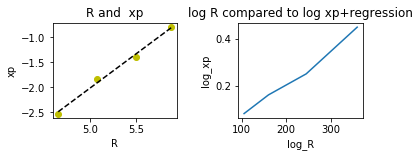2.8 – Practice Problem 1¶
2.8.0 – Learning Objectives¶
By the end of this section you should be able to:
- Understand the Product, effluent and waste streams.
- Plot a logarithmic plot
- Convert a logarithmic plot into a linear plot.
- Roughly asses a plot and its strengths and shortcomings
2.8.1 – Problem statement¶
A pharmaceutical product, P, is made in a batch reactor. The reactor effluent goes through a purification process to yield a final product stream and a waste stream. The initial charge (feed) to the reactor and the final product are each weighed, and the reactor effluent, final product, and waste stream are each analyzed for P.
The analyzer calibration is a series of meter readings, corresponding to known mass fractions of P.
| xp | 0.08 | 0.16 | 0.25 | 0.45 |
|---|---|---|---|---|
| R | 105 | 160 | 245 | 300 |
- Plot the analyzer calibration data on logarithmic axes and determine an expression for ( ).
The data sheet for one run is shown below:
Batch: 23601 Date: 10/4
Mass charged to reactor: 2253 kg
Mass of purified product: 1239 kg
Reactor effluent analysis: R= 388
Final product analysis: R= 583
Waste stream analysis: R= 140
- Calculate the mass fractions of P in all three streams. Then calculate the percentage yield of the purification process,
- You are the engineer in charge of the process. You review the given run sheet and the calculations of part (b), perform additional balance calculations, and realize that all of the recorded run data cannot possibly be correct. State how you know, itemize possible causes of the problem, state which cause is most likely, and suggest a step to correct it
2.8.2 – Answer¶
In [1]:
%matplotlib inline
import matplotlib.pyplot as plt
import numpy as np
xp = np.array([0.08,0.16,0.25,0.45])
R = np.array([105,160,245,360])
log_xp= np.log(xp)
log_R = np.log(R)
fit = np.polyfit(log_R,log_xp,1)
fit_function = np.poly1d(fit)
# fit_function is a function which takes in x and returns an estimate for y
print("Part a)")
fig=plt.figure()
fig1 = fig.add_subplot(221)
plt.xlabel('R')
plt.ylabel('xp')
plt.title('R and xp')
fig2 = fig.add_subplot(222)
# fig1.plt.plot(log_R,log_xp, 'yo', log_R, fit_function(log_R), '--k')
fig1.plot(log_R,log_xp, 'yo', log_R, fit_function(log_R), '--k')
plt.xlabel('log_R')
plt.ylabel('log_xp')
plt.title('log R compared to log xp+regression')
fig2.plot(R,xp)
print("slope:{},y-intercept:{}".format(fit[0],fit[1]))
plt.tight_layout(pad=2, w_pad=2, h_pad=1.0)
Part a)
slope:1.3645457425169734,y-intercept:-8.839384358742016

This is the logarithmic plot:
We want to linearize this logarithmic plot better correlates the data. Taking the exponent of this function to get an expression of x:
In [2]:
print ( "Part b:")
print ("Using the derived power function from part a we will fit \neach of R values from their respective streams.\n\n")
# Remember that fit[] is an array that stores the slope and the y intercept
eff = np.exp(fit[1])*388**fit[0]
final =np.exp(fit[1])*583**fit[0]
waste =np.exp(fit[1])*140**fit[0]
print ("The mass fractions for the individual streams are: \nEffluent: {} \nFinal product: {} \nWaste stream: {}".format(eff,final,waste))
mass_of_P_effluent = 2253 * eff
mass_of_P_product = 1239 *final
P_yield = mass_of_P_product/mass_of_P_effluent*100
print("The yield is: {} percent".format(P_yield))
Part b:
Using the derived power function from part a we will fit
each of R values from their respective streams.
The mass fractions for the individual streams are:
Effluent: 0.4939505334927244
Final product: 0.8609648103559938
Waste stream: 0.12291192587049406
The yield is: 95.85440086928216 percent
In [3]:
print("part C:")
mass_of_P_waste = waste *(2253-1239)
mass_of_waste = 2253-1239
print( "Mass of waste: {}\nMass of P: {}".format(mass_of_waste, mass_of_P_waste))
part C:
Mass of waste: 1014
Mass of P: 124.63269283268097
The mass of P in the product stream plus the waste stream should equal to the mass of P in the effluent stream. Let us check if that is true:
In [4]:
mass_of_P_effluent == mass_of_P_product+mass_of_P_waste
Out[4]:
False
Uh oh
In [5]:
print("Mass of P in the effluent is: {}\nand the mass of the combined stream is: {}".format(mass_of_P_effluent,mass_of_P_waste+mass_of_P_product))
Mass of P in the effluent is: 1112.870551959108
and the mass of the combined stream is: 1191.3680928637573
Errors include: - few data points - inaccurate R readings - inaccurate xp readings - inaccurate weight readings - poor fit of regression - inaccurate model (what if the function is not a power fit)
The error of the mass balance is relatively small. This error is due most likely to the fitted curve from which the R value is interpolated on. The ideal solution is to perform more analyses with more data points.
In [ ]: